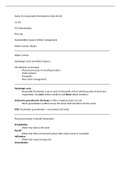College aantekeningen
Volledige aantekeningen hoorcolleges 6 t/m 8 van 'Duurzame ontwikkeling' GEO1-2103 aan Universiteit Utrecht 2021/2022
- Instelling
- Universiteit Utrecht (UU)
Volledige aantekeningen hoorcolleges 'Duurzame ontwikkeling' GEO1-2103 aan Universiteit Utrecht 2021/2022. Alles uitgebreid en overzichtelijk beschreven. De slides zijn gebruikt als voorbeeld en alles is uitgebreid aangevuld met voorbeelden.
[Meer zien]




